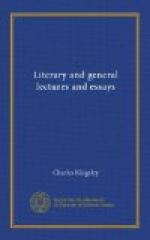No doubt the discovery of huge fossil animals, as Mrs. Jameson says, on the high authority of Professor Owen, may have modified our ancestors’ notions of dragons: but in the old serpent worship we believe the real explanation of these stories is to be found. There is no doubt that human victims, and even young maidens, were offered to these snake-gods; even the sunny mythology of Greece retains horrible traces of such customs, which lingered in Arcadia, the mountain fastness of the old and conquered race. Similar cruelties existed among the Mexicans; and there are but too many traces of it throughout the history of heathendom.
The same superstition may, as the legends assert, have lingered on, or been at least revived during the later ages of the empire, in remote provinces, left in their primeval barbarism, at the same time that they were brutalised by the fiendish exhibitions of the Circus, which the Roman governors found it their interest to introduce everywhere. Thus the serpent became naturally regarded as the manifestation of the evil spirit by Christians as well as by the old Hebrews; thus, also, it became the presiding genius of the malaria and fever which arose from the fens haunted by it—a superstition which gave rise to the theory that the tales of Hercules and the Hydra, Apollo and the mud-Python, St. George and the Dragon, were sanitary-reform allegories, and the monsters whose poisonous breath destroyed cattle and young maidens only typhus and consumption. We see no reason why early Christian heroes should not have




